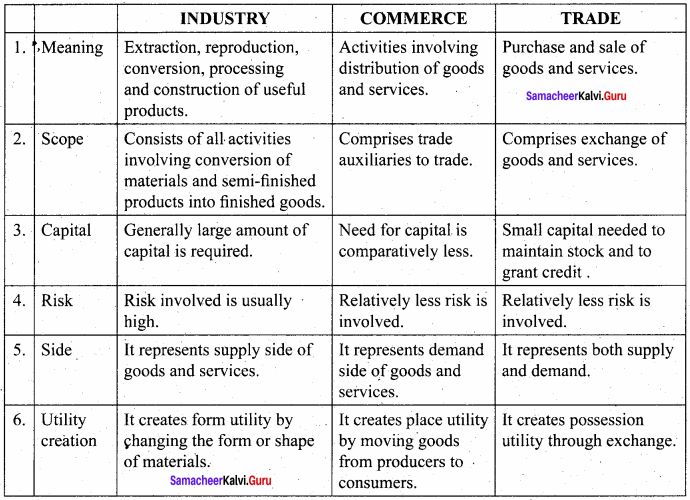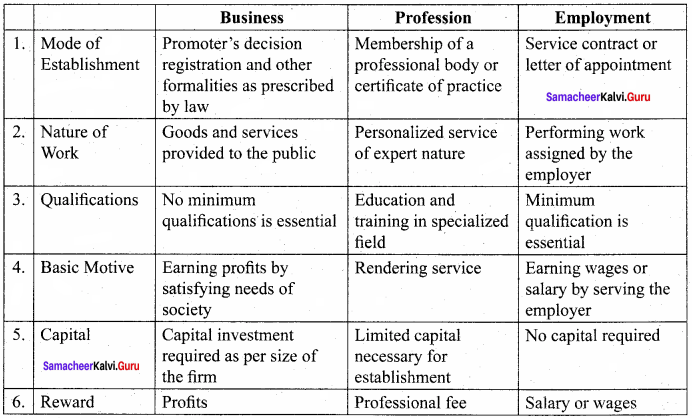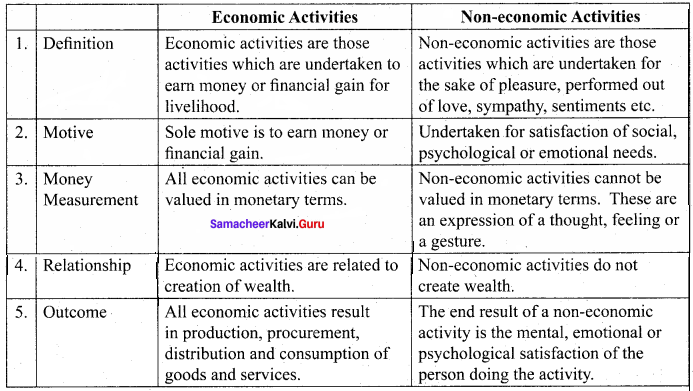Students can Download Economics Chapter 1 Company Secretary Questions and Answers, Notes Pdf, Samacheer Kalvi 11th Economics Book Solutions Guide Pdf helps you to revise the complete Tamilnadu State Board New Syllabus and score more marks in your examinations.
Tamilnadu Samacheer Kalvi 11th Economics Solutions Chapter 1 Introduction To Micro-Economics
Samacheer Kalvi 11th Economics Introduction To Micro-Economics Text Book Back Questions and Answers
Part – A
Multiple Choice Questions
Question 1.
‘Economics is a study of mankind in the ordinary business of life’ -It is the statement of
(a) Adam Smith
(b) Lionel Robbins
(c) Alfred Marshall
(d) Samuelson
Answer:
(c) Alfred Marshall

Question 2.
The basic problem studied in Economics is ……………………….
(a) Unlimited wants
(b) Unlimited means
(c) Scarcity
(d) Strategy to meet all our wants
Answer:
(c) Scarcity
Question 3.
Microeconomics is concerned with
(a) The economy as a whole
(b) Different sectors of an economy
(c) The study of individual economic units behaviour
(d) The interactions within the entire economy
Answer:
(c) The study of individual economic units behaviour
Question 4.
Which of the following is a microeconomics statement?
(a) The real domestic output increased by 2.5 percent last year
(b) Unemployment was 9.8 percent of the labor force last year
(c) The price of wheat determines its demand
(d) The general price level increased by 4 percent last year
Answer:
(c) The price of wheat determines its demand
Question 5.
Find the odd one out:
(a) “An inquiry into the nature and the causes of the Wealth of Nations”
(b) “Principles of Economics”
(c) “Nature and Significance of Economic Science”
(d) “Ceteris paribus”
Answer:
(d) “Ceteris paribus”
Question 6.
The equilibrium price is the price at which ……………………….
(a) Everything is sold
(b) Buyers spend their money
(c) Quantity demanded equals quantity supplied
(d) Excess demand is zero
Answer:
(c) Quantity demanded equals quantity supplied

Question 7.
Author of “An Inquiry into the Nature and Causes of Wealth of Nations”
(a) Alfred Marshall
(b) Adam Smith
(c) Lionel Robbins
(d) Paul A Samuelson
Answer:
(d) Paul A Samuelson
Question 8.
“Economics studies human behavior as a relationship between ends and scarce means which have alternative uses” is the definition of the economics of …………………………
(a) Lionel Robbins
(b) Adam Smith
(c) Alfred Marshall
(d) Paul A Samuelson
Answer:
(a) Lionel Robbins
Question 9.
Who is the Father of Economics?
(a) Max Muller
(b) Adam Smith
(c) Karl Marx
(d) Paul A Samuelson
Answer:
(b) Adam Smith
Question 10.
“Economics is a science” The basis of this statement is …………………………
(a) Relation between cause and effect
(b) Use of deductive method and inductive method for the formations of laws
(c) Experiments
(d) All of the above
Answer:
(d) All of the above
Question 11.
Utility means
(a) Equilibrium point at which demand and supply are equal
(b) Want-satisfying capacity of goods and services
(c) Total value of commodity
(d) Desire for goods and services
Answer:
(b) Want-satisfying capacity of goods and services

Question 12.
A market is ………………………
(a) Only a place to buy things
(b) Only a place to sell things
(c) Only a place where prices adjust
(d) A system where persons buy and sell goods directly or indirectly
Answer:
(d) A system where persons buy and sell goods directly or indirectly
Question 13.
Which one of the following is not a point in the Welfare Definition of Economics?
(a) Study of an ordinary man
(b) Economics does not focus on wealth alone
(c) Economics is the study of material welfare
(d) Economics deals with unlimited wants and limited means
Answer:
(d) Economics deals with unlimited wants and limited means
Question 14.
Growth definition takes into account ……………………….
(a) The problem of choice in the dynamic framework of Economics
(b) The problem of unlimited means in relation to wants
(c) The production and distribution of wealth
(d) The material welfare of human beings
Answer:
(a) The problem of choice in the dynamic framework of Economics
Question 15.
Which theory is generally included under microeconomics?
(a) Price Theory
(b) Income Theory
(c) Employment Theory
(d) Trade Theory
Answer:
(a) Price Theory
Question 16.
……………………….. have exchange value and their ownership rights can be established and exchanged.
(a) Goods
(b) Services
(c) Markets
(d) Revenue
Answer:
(a) Goods
Question 17.
Identify the correct characteristics of utility
(a) It is equivalent to ‘usefulness’
(b) It has moral significance
(c) It is same as pleasure
(d) It depends upon consumer’s mental attitude
Answer:
(d) It depends upon consumer’s mental attitude
Question 18.
Who has given a scarcity definition of economics?
(a) Adam Smith
(b) Marshall
(c) Robbins
(d) Robertson
Answer:
(c) Robbins
Question 19.
The process of reasoning from particular to general is
(a) Deductive method
(b) Inductive method
(c) Positive economics
(d) Normative economics
Answer:
(b) Inductive method
Question 20.
Total revenue is equal to total output sold multiplied by ………………………….
(a) Price
(b) Total cost
(c) Marginal revenue
(d) Marginal cost
Answer:
(a) Price
Part – B
Answer the following questions in one or two sentences
Question 21.
What is meant by Economics?
Answer:
- The term or word ‘Economics’ comes from the Ancient Greek “oikonomikos” [oikos means “households” and nomos means “management” “custom” or “law”.
- Thus, the term “Economics” means “management of households”.
- The subject was earlier known as “Political Economy” is renamed as Economics.

Question 22.
Define microeconomics?
Answer:
- Microeconomics is the study of the economic actions of individual units say households, firms, or industries.
- It studies how business firms operate under different market conditions.
- The combined actions of buyers and sellers determine prices.
- Microeconomics covers:
- Value theory [product pricing and factor pricing]
- Theory of economic welfare.
Question 23.
What are the goods?
Answer:
Goods are also called:
- Products
- Commodities
- Things
- In Economics, the term ‘goods’ implies the term ‘services’.
Question 24.
Distinguish goods from services.
Answer:
| S.No. |
Goods |
Services |
| 1. |
Material things, tangible |
Intangible |
| 2. |
Exist independently of their owner |
Inseparable from their makers |
| 3. |
Transferable have value – in – exchange |
Services cannot be stored as inventories like goods. |
Question 25.
Name any two types of utility?
Answer:
- Time Utility: A sick man derives time utility from blood, not at the time of its donation. but only at the operation – time, i.e., when it is used.
- Place Utility: A student derives place utility from a book not at the place of its publication (production centre) but only at the place of his education (consumption centre).
Question 26.
Define positive economics.
Answer:
Positive economics deals with what it is, its means, it analyses a problem on the basis of facts and examines its causes.
Question 27.
Give the meaning of the deductive method?
Answer:
- The deductive method is also named an analytical or abstract method.
- It consists in deriving conclusions from general truths.
- It takes few general principles and applies them to draw conclusions.
- The classical and neo-classical schools of economists notably, Ricardo, JS Mill, Malthus Marshall, Pigou applied the deductive method in their economic investigations.
Part – C
Answer the following questions in One Paragraph
Question 28.
Explain the scarcity definition of Economics and assess it.
Answer:
Lionel Robbins published a book “An Essay on the Nature and Significance of Economic Science”. In it, he defined “Economics is a science which studies human behavior as a relationship between ends and scarce means which have alternative uses”.
Assessment:
- Robbins does not make any distinction between goods conducive to human welfare and goods that are not.
- Economics deals not only with the microeconomic aspects but also with the macroeconomic aspects like how national income is generated. Robbins reduces economics merely to the theory of resource allocation.
- Robbin’s definition does not cover the theory of economic growth and development.
Question 29.
What are the crucial decisions involved in ‘what to produce’?
Answer:
Every society much decides on what goods it will produce and how much of these it will produce.
In this process, the crucial decisions include:
- Whether to produce more food, clothing, and housing or to have more luxury goods.
- Whether to have more agricultural goods or to have industrial goods and services.
- Whether to use more resources in education and health or to use more resources in military services.
- Whether to have more consumption goods or to have investment goods.
- Whether to spend more on basic education or higher education.
Question 30.
Explain different types of economic activities.
Answer:
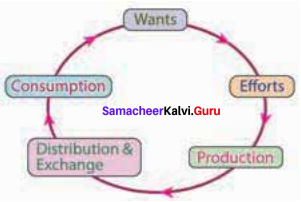
- Economics focuses on the behavior and interactions among economic agents, individuals, and groups in the economic system.
- It deals with the consumption and production of goods and services and distribution of income among the factors of production.
- It includes the activities of the rational human beings under the existing social, legal, and institutional arrangement.
- It studies the way in which people use the available resources to satisfy their multiplicity of wants.

Question 31.
Elucidate different features of services?
Answer:
Along with goods, services are produced and consumed. They are generally, possess the following:
1. Intangible:
- Intangible things are not physical objects but exist in connection to other things, for example, brand image, goodwill, etc.
- The intangible things are converted and stored into tangible items such as recording a music piece into a pen drive.
2. Heterogeneous:
- Services vary across regions or cultural backgrounds.
- A single type of service yields multiple experiences, e.g., music, consulting physicians, etc.
3. Inseparable from their makers:
- Services are inextricably connected to their makes. For example, labour and labourers are inseparable.
4. Perishable:
- Services cannot be stored as inventories like assets.
- For example, it is useless to possess a ticket for a cricket-match once the match is over.
- It cannot be stored and it has no value-in-exchange.
Question 32.
What are the important features of utility?
Answer:
Utility: Utility is the want satisfying power of a commodity or a service. Features of utility :
- Utility is psychological.
- Utility is not equivalent to usefulness.
- Utility is not the same as pleasure.
- Utility is personal and relative.
- Utility is the function of the intensity of human want.
- Utility is a subjective concept.
- Utility has no ethical or moral significance.
Question 33.
Distinguish between microeconomics and macroeconomics
Answer:
| S.No. |
Micro Economics |
Macro Economics |
| 1. |
It deals with the economic decision-making of individual economic agents. |
It deals with aggregates and averages of the entire economy. |
| 2. |
It accounts only small components of the whole economy. |
It considers the economy of the country as a whole. |
| 3. |
It deals with the price determination of individual products and factors of production. |
It deals with the general price – level in any economy. |
| 4. |
It is concerned with the optimization goals of individual consumers and producers |
It is concerned with the optimization of the growth process of the entire economy. |
Question 34.
Compare positive economics and normative economics.
Answer:
Positive economics deals with what it means, it analyses a problem on the basis of facts and examines its causes whereas, Normative economics responds to a question like what ought to be.
Positive Economics:
- An increase in the money supply implies a price rise in an economy.
- As the irrigation facilities and application of chemical fertilizers expand, the production of food – grains increases.
- An increase in birth rate and a decrease in the death rate reflect the rate of growth of the population.
Normative Economics:
- Inflation is better than deflation.
- More production of luxury goods in not good for a less developed country.
- Inequalities in the distribution of wealth and incomes should be reduced.
Part – D
Answer the following questions in about a page
Question 35.
Compare and contrast various definitions of Economics?
Answer:
1. Wealth Definition: “Adam Smith”
Adam Smith in his book “An inquiry into nature and causes of the wealth of nations” (1776) defines “Economics as the science of wealth”
Criticism:
- For Smith, Economics consists of ‘Wealth getting’ activities and ‘Wealth – spending’ activities.
- An undue emphasis is given to material wealth.
- It ignores human welfare which is an essential part of economics.
- Ruskin and Carlyle regard economics as a ‘dismal science’, “Pig Science” etc as it is against ethics.
2. Welfare Definition: “Alfred Marshall”
Alfred Marshall is his book “Principles of Economics” (1890) defines economics as: “Political Economy” or economics is a study of mankind in the ordinary business of life; it examines that part of individual and social action which is most closely connected with the attainment and with the use of the material requisites of well-being. Thus, it is on one side a study of wealth; and on the other and more important side, a part of the study of man.
Criticism:
- Marshall regards only material things.
- He does not consider immaterial things, such as the services of a doctor, a teacher, and so on.
- The concept of welfare is not clearly defined.
- Welfare varies with the person, country, and time period.
- Welfare not only depends on the stock of wealth possessed but also on the political, social, and cultural activities of the nation.
3. Scarcity Definition: “Lionel Robbins”
Lionel Robbins published a book “An essay on the nature and significance of economic science (1932). In it, he defined “Economics is a science which studies human behaviour as a relationship between ends and scarce means which have alternative uses”.
Criticism:
- Robbins does not make any distinction between goods conducive to human welfare and goods that are not.
- Economics deals not only with the microeconomic aspects but also with the macro-economic aspects like how national income is generated.
- Robbin’s definition does not cover the theory of economic growth and development.
4. Growth Definition: “Samuelson”
Paul Samuelson defines economics as “The study of how men and society choose, with or without the use of money to employ scarce productive resources which could have alternative uses, to produce various commodities over time, and distribute them for consumption now and in the future among various people and groups of society”.
Criticism:
- Like Kohbin Samuelson states that the means are scarce in relation to unlimited ends.
- Samuelson makes his definition dynamic by including the element of time in it.
- It covers various aspects like production, distribution, and consumption.
- Samuelson treats economics as a social science in contrast to Robbins regards it as a science.
Conclusion:
Of all the definitions discussed above the growth definition stated by Samuelson appears to be the most satisfactory.
Question 36.
Explain various steps of deductive and inductive methods.
Answer:
Steps of deductive method :
- Should have a clear and precise idea of the problem.
- Definition of technical terms and assumptions.
- Deducing hypothesis.
- Verification of hypotheses
Steps of inductive method :
- Data collection and arrangement.
- By observing the data conclusions are drawn easily.
- Generalization of data and hypothesis formulation.
- Verification of hypothesis.
Question 37.
Elaborate on the nature and scope of Economics.
Answer:
Economics nature:
- The nature of a subject refers to its contents and how and why they find a place in the subject.
- This nature is understood by studying the various definitions given by notable economists.
- The existence of a multiplicity of definitions makes some scholars comment that a search for a clear definition of economics is an exercise in futility.
- “Political economy is said to have strangled itself with definitions.”
- Their presence makes studying a subject interesting, exciting, enjoyable or worthwhile.
- In fact, their presence in a social science subject is a clear sign of the growth of the science.
- It indicates that there exists freedom for people associated with such as science to formulate fresh definitions.

Scope of Economics:
- The scope of the subject of Economics refers to the subject matter of economics.
- It throws light on whether it is an art or science and if science, whether it is a positive science or normative science.
Economics – Its Subject Matter:
- Economics focuses on the behaviour and interactions among economic agents, individuals, and groups belonging to an economic system.
- Economics studies the ways in which people use the available resources to satisfy their multiplicity of wants.
- The activities of rational or normal human beings are the subject-matter of Economics.

Question 38.
Explain basic problems of the economy with the help of the production possibility curve. Production possibility curve :
Answer:
The Problem of choice between relatively scarce commodities due to limited resources can be illustrated with the help of a geometric device, is known as the production possibility curve
Basic problems of the Economy:
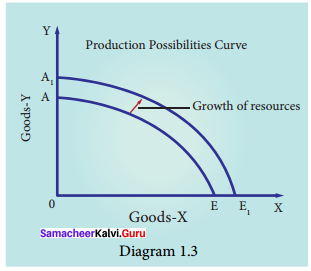
(i) The problem of choice :
- The problem of choice arises because of the given limited resources and unlimited wants.
- It may be related to the allocation of resources between people of different standards.
- Since PPC is the locus of the combination of the goods the problem of choice will not arise.
(ii) The Notion of scarcity :
- We can explain the notion of scarcity with the help of PPC.
- Every society possesses only a specific amount of resources, which can produce only a limited amount of output even with the help of the best technology.
- The PPC reflects the constraints imposed by the element of economic scarcity.
(iii) Solution of central problems :
- The central problems of an economy can be explained with the help of PPC.
- The solution for what to produce involves the decision regarding the choice of location on the production possibility curves.
- A production combination represented by any point inside the PPC indicates that the economy is using inefficient methods of production and a combination of resources.
Samacheer Kalvi 11th Economics Introduction To Micro-Economics Additional Questions and Answers
Part – A
Choose the best options
Question 1.
In Economics, we make use of ………………………
(a) Deductive Method
(b) Inductive Method
(c) Both
(d) None
Answer:
(c) Both

Question 2.
Adam Smith wrote “Wealth of Nations” in
(a) 1723
(b) 1890
(c) 1776
(d) 1932
Answer:
(c) 1776
Question 3.
Who wrote the book “Principles of Economics” in 1890?
(a) Adam Smith
(b) Alfred Marshall
(c) Lionel Robbins
(d) Samuelson
Answer:
(b) Alfred Marshall
Question 4.
Lionell Robbins book, “An essay on the nature and significance of economic science” was published in
(a) 1932
(b) 1776
(c) 1723
(d) 1890
Answer:
(a) 1932
Question 5.
Production refers to the creation of ……………………….
(a) Price
(b) Market
(c) Cost
(d) Utilities
Answer:
(d) Utilities
Question 6.
is the unit of measurement of utility.
(a) Price
(b) Utils
(c) Consumption
(d) Human wants
Answer:
(b) Utils
Question 7.
Perishable goods are ………………………..
(a) Long Term Lived
(b) Short Term Lived
(c) Medium Term Lived
(d) Longer Life Time Lived
Answer:
(b) Short Term Lived
Question 8.
“The proportion of total expenditure incurred on food items declines as total expenditure goes on increasing” is
(a) Marshall’s law
(b) Adam Smith’s law
(c) Engel’s law
(d) Samuelson’s law
Answer:
(c) Engel’s law
Question 9.
……………………… The economy is the other name for economics.
(a) Wealth
(b) Welfare
(c) Scarcity
(d) Political
Answer:
(d) Political
Question 10.
The utility can be measured indirectly using the ‘Measuring rod of money’ is the statement of
(a) Adam Smith
(b) Samuelson
(c) Marshall
(d) Lionel Robbins
Answer:
(c) Marshall

Question 11.
……………………. goods don’t directly satisfy the consumer.
(a) Capital
(b) Consumer
(c) Free
(d) Economic
Answer:
(a) Capital
Match the following and choose the answer using the codes given below
Question 1.
| (a) |
Adam Smith |
(1) |
Nature and significance of economic science |
| (b) |
Alfred Marshall |
(2) |
Net economic welfare |
| (c) |
Robbins |
(3) |
Principles of Economics |
| (d) |
Samuelson |
(4) |
Wealth of nations |
(a) 3 4 2 1
(b) 1 2 3 4
(c) 4 2 3 1
(d) 2 4 3 1
Answer:
(a) 3 4 2 1
Question 2.
| (a) |
Goods |
(1) |
Man-made |
| (b) |
Services |
(2) |
Nature |
| (c) |
Free good |
(3) |
Tangible |
| (d) |
Consumer good |
(4) |
Intangible |
(a) 1 2 3 4
(b) 2 4 3 1
(c) 4 3 2 1
(d) 3 4 2 4
Answer:
(c) 4 3 2 1
Choose the correct statement
Question 3.
(a) Utility is equal to the usefulness
(b) Utility is the same as pleasure
(c) Utility is an objective concept
(d) Utility has no ethical or moral significance
Answer:
(d) Utility has no ethical or moral significance
Question 4.
(a) Consumption is the result of the co-ordination of factors of production
(b) Macro Economics is the obverse of micro Economics
(c) Macro Economics is called price theory
(d) production studies about the pricing of factors of production
Answer:
(b) Macro Economics is the obverse of micro Economics
Choose the incorrect pair
Question 5.
| (a) |
Micro Economics |
i |
Value theory |
| (b) |
Macro Economics |
ii |
Income theory |
| (c) |
International Economics |
iii |
Happiness index |
| (d) |
Public finance |
iv |
Financial Administration |
Answer:
(c) International Economics – Happiness index
Question 6.
| (a) |
Adam Smith |
i |
Classical era |
| (b) |
Marshall |
ii |
Neoclassical era |
| (c) |
Robbins |
iii |
New age |
| (d) |
Samuelson |
iv |
Old age |
Answer:
(d) Samuelson iv Old age
Choose the odd one out
Question 7.
(a) Form unity
(b) Place utility
(c) Time utility
(d) Total utility
Answer:
(d) Total utility

Question 8.
(a) Net economic
(b) Wealth definition
(c) welfare definition
(d) scarcity definition
Answer:
(a) Net economic
Choose the correct pair
Question 9.
| (a) |
International economics |
i |
Public investment |
| (b) |
Health economics |
ii |
Drug price control |
| (c) |
Developmental economics |
iii |
Ecology and environment |
| (d) |
Environment economics |
iv |
Human development index |
Answer:
(b) Health economics (ii) Drug price control
Question 10.
| (a) |
Equilibrium |
i |
Keynes |
| (b) |
Utils |
ii |
Marshall |
| (c) |
Ragnar Frisch |
iii |
England |
| (d) |
Neo-classical school |
iv |
Adam smith |
Answer:
(b) Utils (ii) Marshall
Choose the incorrect statement
Question 11.
(a) Macroeconomics is concerned with the economy as a whole
(b) Microeconomics is the study of economic actions of individual units
(c) Health economics is an area of applied economics
(d) International economics analyses the interrelationship between economy and environment.
Answer:
(d) International economics analyses the interrelationship between economy and environment.
Question 12.
(a) Economics is an art – A.C. Pigou, Marshall
(b) Economics is a science – Robbins, Jordan
(c) Economic laws are a statement of tendencies – Adam Smith
(d) Political economy is said to have strangled itself with definitions – Keynes
Answer:
(c) Economic laws are a statement of tendencies – Adam Smith
Analyze the reason for the following
Question 13.
Assertion (A): Deductive method derives conclusions from general truth.
Reason (R): Hypotheses can be verified through direct observation and statistical methods
(a) Both (A) and (R) are true, (R) is the correct explanation of (A)
(b) Both (A) and (R) are true, (R) is not the correct explanation of (A)
(c) (A) is true, (R) is false.
(d) Both (A) and (R) are false.
Answer:
(b) Both (A) and (R) are true, (R) is not the correct explanation of (A)

Question 14.
Assertion (A): In every society, certain choices have to be made.
Reason (R): Resources are always scarce but wants are numerous.
(a) Both (A) and (R) are true, (R) is the correct explanation of (A)
(b) Both (A) and (R) are true, (R) is not the correct explanation of (A)
(c) (A) is true, (R) is false.
(d) (A) is false (R) is true.
Answer:
(a) Both (A) and (R) are true, (R) is the correct explanation of (A)
Fill in the blanks with the suitable option given below
Question 15.
The value of goods expressed in money terms is
(a) Revenue
(b) Market
(c) Price
(d) Cost
Answer:
(c) Price
Question 16.
Alfred Marshall wrote “Principles of Economics” in
(a) 1776
(b) 1932
(c) 1723
(d) 1890
Answer:
(d) 1890
Question 17.
______ is the assumption in economics that makes the economic laws hypothetical
(a) Other things remaining the same
(b) Time remaining the same
(c) Money remaining the same
(d) Wants to remain the same
Answer:
(a) Other things remaining the same
Choose the best option
Question 18.
Examples for perishable goods
(a) Television, furniture
(b) Table, chair
(c) Fish, fruits, flowers
(d) Vehicles, capital goods
Answer:
(c) Fish, fruits, flowers
Question 19.
The proportion of total expenditure incurred on food items declines as total expenditure goes on increasing is
(a) Marshall’s law
(b) Samuelson’s law
(c) Adam smith’s law
(d) Engel’s law
Answer:
(d) Engel’s law
Question 20.
The utility can be measured indirectly using the ‘Measuring rod of money’ is the statement of
(a) Marshall
(b) Samuelson
(c) Robbins
(d) Frisch
Answer:
(a) Marshall
Part – B
Answer the following questions in one or two sentences
Question 1.
What is scarcity?
Answer:
Scarcity is the gap between what people want and what they are able to get.

Question 2.
Define normative economics?
Answer:
- Inflation is better than deflation.
- More production of luxury goods is not good for a less-developed country.
- Inequalities in the distribution of wealth and incomes should be reduced.
Question 3.
Explain Value.
Answer:
Value is the power of a commodity to command other commodities in exchange.
Question 4.
What is Income?
Answer:
Income is the amount of monetary or other returns, either earned or unearned, accruing over a period of time.
Question 5.
Give the meaning of the Inductive method.
Answer:
Induction is a process in logic facilitative or arriving at an inference, moving from particular to the general.
Question 6.
What are the kinds of goods?
Answer:
- Consumer goods
- Capital goods
- Perishable goods
- Durable goods
Part – C
Answer the following questions in One Paragraph
Question 1.
What are the four definitions of economics?
Answer:
Based on the particular stage of the growth of the subject of economics, the four definitions are presented here.
- Smith’s wealth definition, representing the classical era.
- Marshall’s welfare definition, representing the Neo-classical era.
- Robbin’s scarcity definition representing the new age.
- Samuelson’s growth definition representing the modern age.
Question 2.
Explain the steps of the deductive method?
Answer:
Steps of deductive method:
- Step 1: The analyst must have a clear and precise idea of the problem to be inquired into.
- Step 2: The analyst clearly defines the technical terms used in the analysis. Further, the assumptions of the theory are to be precise.
- Step 3: Deduce hypothesis from the assumptions taken.
- Step 4: Hypotheses should be verified through direct observation of events in the real world and through statistical methods. [e.g.] There exists an inverse relationship between price and quantity demanded of a good.
Question 3.
Whether economics is an art or science? Explain.
Answer:
1. Economics as an art:
Art is the practical application of knowledge for achieving particular goals. Economics provides guidance to the solutions to all the economic problems.
A.C. Pigou, Alfred Marshall, and others regard economics as an art.
2. Economics as a science :
Science is a systematic study of knowledge. Science develops the co-relation between cause and effect based on facts.
Economics examines the relationship between the cause and effect of the problems. Hence, it is rightly considered as both an art and a science.
Question 4.
State the importance of microeconomics.
Answer:
- To understand the operation of an economy.
- To provide tools for economic policies.
- To examine the condition of economic welfare.
- Efficient utilization of resources.
- Useful in international trade.
- Useful in decision making.
- Optimal resource allocation.
- The basis for prediction.
- Price determination.
Question 5.
What are the methods of economic analysis?
Answer:
There are two types of methods used in economics.
i. Deductive Method :
- It is also named as an analytical or abstract method.
- It is a process in logic facilitating or arriving at an inference, moving from general to particular.
- It consists of deriving conclusions from general truths.
ii. Inductive method :
The inductive method is also called as empirical method. It involves the process of reasoning from particular facts to the general principles. In this method, economic generalizations are derived based on
- Experimentations
- Observations
- Statistical methods
Alfred Marshall has rightly remarked “Inductive and Deductive methods are both needed for scientific thought as the right and left foot are both needed for walking”
Part – D
Answer the following questions in about a page
Question 1.
Explain the production possibility curve with a diagram.
The problem of choice between relatively scarce commodities can be illustrated with a help of a geometric device known as the production possibility curve.
Assumptions:
The analysis of the production possibility curve is based on certain assumptions :
- The time period remains constant.
- Techniques of production are fixed.
- Only two goods can be produced from the given resources.
- There is full employment in the economy.
- Resources of production are fully mobile.
- The factors of production are given in quantity and quality.
- The law of diminishing returns operates in production.
Production possibility schedule:
| Production Possibilities |
Quantity of food production in tons |
No. of car produced |
| I |
0 |
25 |
| II |
100 |
23 |
| III |
200 |
20 |
| IV |
300 |
15 |
| V |
400 |
8 |
| VI |
500 |
0 |
Explanation :
The above schedule suggests that if all resources are used for food production a maximum of 500 tons of food can be produced, given the existing technology. Instead, if all resources are used for producing cars, 25 cars can be produced. In between these two extreme possibilities exist, if we are willing to give up some food, we can have some cars.
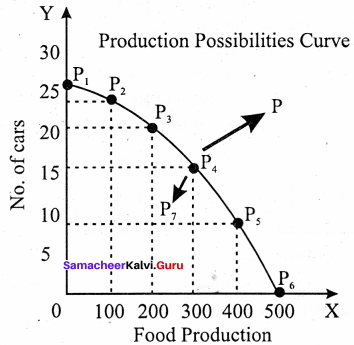
Diagram Explanation :
- The quantity of food is shown on the x-axis and the number of cars on the y-axis.
- Six different production possibilities P1, P2, P3, P4, P5, P6 are shown.
- Point outside the curve P cannot be attained due to limited resources.
- A point inside the curve P7 can be attained but at these points, resources are not fully employed
Question 2.
What are the basic economic problems?
Answer:
Basic economics problems:
- If resources are abundant and wants are so few, then there would be no economic problem.
- But this situation can never exist.
- Resources are always scarce and our wants are numerous.
Hence in every society, certain choices have to be made.
The Economic Problem:
- Wants desires; unlimited
- Resources: Scarce – Not freely available
- Economic choice
- Economics – How people use scarce resources to satisfy unlimited wants.
What and how much to produce?
- Every society must decide on what goods it will produce and how much of these it will produce.
In this process, the crucial decisions include:
- Whether to produce more food, clothing, and housing or to have more luxury goods.
- Whether to have more agricultural goods or to have industrial goods and services.
- Whether to use more resources in education and health or to use more resources in military services.
- Whether to have more consumption goods or to have investment goods.
- Whether to spend more on basic education or higher education.
How to produce?
- Every society has to decide whether it will use labor-intensive technology on capital-intensive technology; that is whether to use more labor and less more machines and vice versa.
For whom to produce?
- Every society must also decide how its produce be distributed among the different sections of the society.
- It must also decide who gets more and who gets less.
- It should also decide whether or not a minimum amount of consumption be ensured for everyone in the society.
- Due to the scarcity of resources, society faces the compulsion of making choices among alternatives.
- It faces the problem of allocating the scarce resources to the production of different possible goods and services and of distributing the produced goods and services among individuals within the economy.
![]()
![]()
![]()
![]()
![]()



